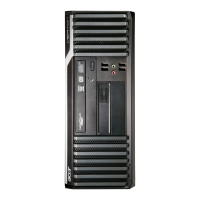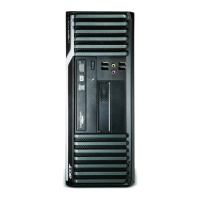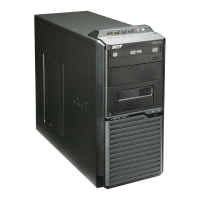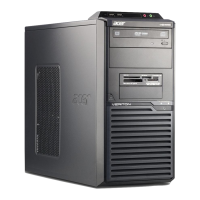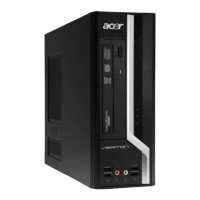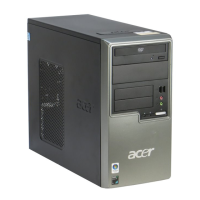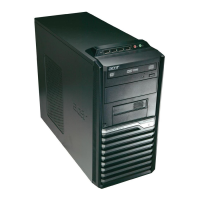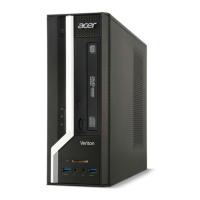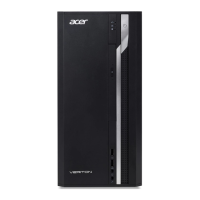
Do you have a question about the Acer Veriton S2710G and is the answer not in the manual?
Explains the different guides provided with the computer for setup and use.
Provides essential advice for maintaining the computer's performance and longevity.
Guides on establishing an internet connection wirelessly via Wi-Fi or WLAN.
Provides instructions for establishing an internet connection using a wired Ethernet cable.
Explains how to use the computer's built-in network port for a wired internet connection.
Provides an overview of Acer ProShield, an all-in-one security solution for the computer.
Guides the user through the initial setup process for Acer ProShield security features.
Explains how to create and use a secure section on the hard disk for saving files.
Details managing user credentials, passwords, and online account configurations.
Guides on file encryption, decryption, and managing the Personal Secure Drive.
Explains how to permanently delete files using the File Shredder feature.
Explains how to set the boot sequence within the BIOS utility for system startup.
Details the process of setting BIOS passwords for system security and boot control.
Describes various password types (Supervisor, User, Password on Boot) for enhanced computer security.
Explains how password prompts appear and how to correctly enter them during system operations.
Discusses power-saving features and how to disable fast startup for reduced power consumption.
Provides key details about USB 3.0 ports, their features, and compatibility.
Explains the function and color-coding of audio jacks on the computer's rear panel.
Guides on the correct procedure for inserting various types of memory cards into the reader.
Describes different types of SD cards, their capacities, and compatibility.
Details the steps for safely ejecting and removing a memory card from the reader.
Explains how to connect audio devices like headphones, speakers, and microphones to the computer.
Troubleshoots issues where the computer fails to power on or initiate the startup process.
Addresses problems with a blank screen, often related to display settings or power saving modes.
Provides steps to diagnose and resolve issues with no sound output from the computer.
Explains how to manually eject the optical drive tray using a pin or paperclip.
Offers troubleshooting steps for a non-responsive keyboard, including checking connections.
Guides on checking printer connections, power, and cable integrity when it fails to operate.
Details the process of performing a system restore to the computer's original factory state.
Explains the International Travelers Warranty program and its benefits for users traveling abroad.
Lists essential information to have ready before contacting Acer support for assistance.
Explains how to access the Windows 10 Start menu and its basic functions.
Guides on how to view a list of all installed applications on the computer.
Details the correct procedures for shutting down or restarting the Windows 10 computer.
Explains how to customize the Windows 10 lock screen with images or slideshows.
Guides on organizing tiles into groups on the Windows Start screen for better usability.
Explains how to adjust the display's screen resolution settings in Windows.
Guides on using the Windows 10 alarm clock feature to set alarms with custom sounds and times.
Helps users locate and open installed applications on their Windows 10 system.
Details how to download and install applications from the Windows Store.
Defines what a Microsoft account is and its role in Windows and online services.
Guides on how to check for and install important Windows 10 updates for security and performance.
Provides links and resources for obtaining additional information about Windows and Acer support.
Offers general advice and methods for diagnosing and resolving common computer system problems.
Lists common error messages encountered on the system and their recommended corrective actions.
Provides initial guidance on protecting the computer and getting connected to the internet safely.
Guides on selecting an Internet Service Provider (ISP) for internet access.
Describes various methods for connecting to the internet, such as dial-up, DSL, and cable.
Details DSL internet connections, including requirements, speed, and monthly charges.
Explains cable internet service, its availability, and usage.
Describes 3G mobile broadband connections using cellular networks for internet access.
Explains Local Area Networks (LAN) and wireless networks for sharing resources and internet.
Lists the necessary hardware components for setting up a home wireless network.
Explains the function of access points and routers as mediators in wired and wireless networks.
Describes the RJ45 network cable used for connecting computers to networks and peripherals.
Guides on managing wireless network connections using network management options.
Explains how to use an internet browser to access websites and browse the web.
Provides information on accessing the Acer website for support, downloads, and product information.
Discusses pre-installed McAfee Internet Security Suite for protecting the computer online.
Defines computer viruses, their transmission methods, and potential impact.
Defines spyware, its functions like snooping and data collection, and its risks.
Explains malware, including viruses, worms, and Trojan horses, and the need for antivirus software.
Defines a personal firewall as a security program that prevents unauthorized network access.
Emphasizes the importance of installing the latest software patches and updates for security.
Highlights the necessity of using firewall and antivirus software for basic online safety.
Offers tips for creating strong, unique passwords and keeping them secure to prevent unauthorized access.
Advises caution when sharing personal information online and provides tips for safe practices.
Guides on identifying and avoiding fraudulent emails, such as phishing attempts.
Warns against clicking on links in emails unless specifically requested and verified.
Advises on identifying and avoiding fake websites designed to steal personal information.
Recommends regularly reviewing bank and credit card statements to detect fraudulent activity early.
Highlights Windows features like updates and Action Center for computer protection.
Guides on recognizing signs of a computer being at risk or infected by malware.
Explains DVD region codes, their country assignments, and limitations on playback.
